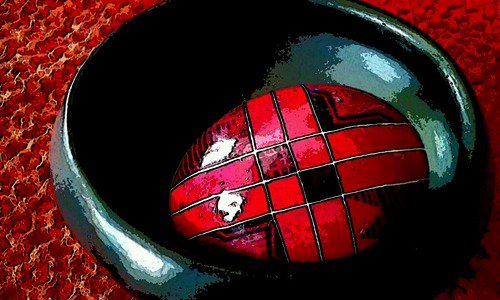Happy Eostre. The Gift, Droid Shots, Minneapolis, Minnesota, March 2013, photo © 2015 by QuoinMonkey. All rights reserved.
season of Eostre:
abundance lives
in the skillful art
of not placing all your eggs
in one basket
___________________________________________
A few years ago, I was getting a haircut when a woman walked in bearing gifts. She carried a basket of hollow, elaborately decorated eggs and asked the patrons in the shop if they would like to choose one to take with them. I had seen pysanky (what we called Ukrainian Easter eggs) before, but had never taken part in the gift-giving ritual. It lit up my day. I took the oval-shaped treasure home and placed it in a raku bowl on my altar where it lived for many months.
There is a booklet produced by the American Folklife Center (1982, long out of print) that gives a brief description of European egg decorating traditions, and explains the techniques (complete with black and white photos) for producing elaborate designs. EggArt can be found in the online collections of the American Folklife Center, Library of Congress (LINK). Here is an excerpt:
Egg Art Cover Image: Easter Eggs Decorated with Various Traditional Patterns. Photo by Carl Fleischhauer, 1982.
Traditionally, the egg, both plain and decorated, has been an object with strong mystical and symbolic force throughout the world. It has been associated with the myth of creation, with the concept of birth, and with the hope for abundance. Eggs have been sacrificed to sanctify the construction of dwellings, public buildings, and bridges in many lands. They are traditionally given at the birth of a son in China, and they have been used for fortune telling in the British Isles. In many Western cultures the egg has become an integral part of the complementary celebrations of the Easter season and of the renewal of life in spring.
It is in Eastern Europe, however, where Christian associations with the egg were grafted onto strong, pagan beliefs which connected the egg with sun worship, worship of the renewal of life in spring, and with rituals to maintain or restore health, that the rich traditions surrounding eggs have remained strongest. More secular traditions practiced in the spring by communities of European ancestry include egg tapping, egg gathering or hunting, egg rolling, and egg tossing contests.
It is said that the Venerable Bede, (672-735 CE), a Christian scholar and monk, first asserted in his book De Ratione Temporum that Easter was named after Eostre (or Eastre, the ancient word for spring). And that Eostre, the Great Mother Goddess of the Saxon people, Germanic Goddess of Spring, gave her name to the Christian festival of Easter. After the dark Midwest winter, I find it an uplifting season, and feel grounded in the timing still dictated by the Moon.
-posted on red Ravine, Saturday, April 4th, 2015
-Part of a yearly practice to write a short form piece of poetry in a Moleskine journal once a day for the next year. Related to post: haiku 4 (one a day) Meets renga 52




























